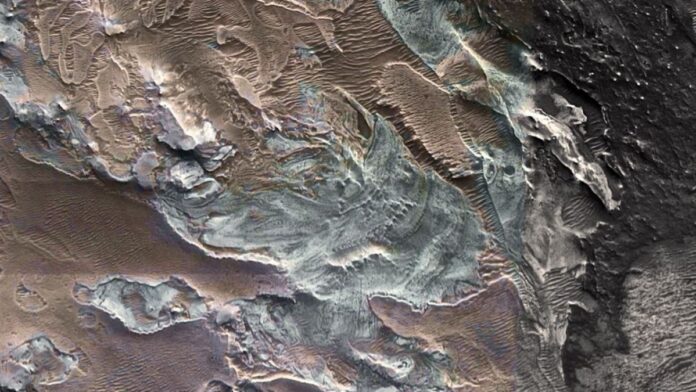Remnants of a modern glacier have been found near Mars’ equator, suggesting ice may still exist at shallow depths in the area. If confirmed, such a discovery could have significant implications for future human exploration on the Red Planet.
Using data from the High Resolution Imaging Science Experiment (HiRISE) on NASA’s Mars Reconnaissance Orbiter (MRO), researchers from the SETI Institute and the Mars Institute detected light-toned deposits (LTDs) on the Martian surface. These features consist of light-colored sulfate salts, crevasse fields and moraine bands, which are signs of a “relict glacier.”
This relict glacier is located near Mars’ equator at 7° 33′ S, 93° 14′ W, and is estimated to be 3.7 miles (6 kilometers) long and up to 2.5 miles (4 km) wide, with a surface elevation reaching up to 1.1 miles (1.7 km), according to a statement (opens in new tab) from the SETI Institute.
Related: How can astronauts explore Mars’ Grand Canyon, Valles Marineris
“What we’ve found is not ice, but a salt deposit with the detailed morphologic features of a glacier,” Pascal Lee, lead author of the study and a planetary scientist with the SETI and Mars Institutes, said in the statement. “What we think happened here is that salt formed on top of a glacier while preserving the shape of the ice below, down to details like crevasse fields and moraine bands.”
The presence of such a glacier suggests there may have been surface water ice on Mars more recently than previously thought, which has implications on both our understanding of the Red Planet’s habitability and future exploration missions.
“This region of Mars has a history of volcanic activity. And where some of the volcanic materials came in contact with glacier ice, chemical reactions would have taken place at the boundary between the two to form a hardened layer of sulfate salts,” Sourabh Shubham, co-author of the study and graduate student at the University of Maryland’s Department of Geology, said in the statement. “This is the most likely explanation for the hydrated and hydroxylated sulfates we observe in this light-toned deposit.”
The LTDs observed are made up of sulfate salts that form when freshly erupted pyroclastic materials — volcanic ash, pumice and hot lava — come in contact with water ice. As these deposits build up, they form a hardened, crusty salt layer. Over time, erosion would have exposed the salt deposits, along with crevasses and moraine bands, which are unique to glaciers.
“Glaciers often present distinctive types of features, including marginal, splaying, and tic-tac-toe crevasse fields, and also thrust moraine bands and foliation,” John Schutt, co-author of the study and a geologist at the Mars Institute, said in the statement. “We are seeing analogous features in this light-toned deposit, in form, location, and scale. It’s very intriguing.”
Previous research has found glacial activity near Mars’ equator in the more distant past, whereas more recent glacial activity has only been seen at higher latitudes until now. The recent HiRISE observations suggest that these low latitude LTDs are geologically young, according to the statement.
“A relatively young relict glacier in this location tells us that Mars experienced surface ice in recent times, even near the equator, which is new,” Lee said in the statement.
Although water ice is not stable at the surface of Mars near the equator at these elevations, it is possible that some of the glacier’s water ice may be preserved beneath the sulfate salts. Further research is needed to confirm, but if water ice is in fact present at this equatorial region, there’s the possibility it could be extracted as a resource for future missions.
“The desire to land humans at a location where they might be able to extract water ice from the ground has been pushing mission planners to consider higher latitude sites. But the latter environments are typically colder and more challenging for humans and robots. If there were equatorial locations where ice might be found at shallow depth, then we’d have the best of both environments: warmer conditions for human exploration and still access to ice,” Lee said in the statement. “We now have to determine if, and how much, water ice might actually be present in this relict glacier, and whether other light-toned deposits might also have, or have had, ice-rich substrates.”
The findings were presented (opens in new tab) at the 54th Lunar and Planetary Science Conference held in The Woodlands, Texas, on March 15.
Follow Samantha Mathewson @Sam_Ashley13 (opens in new tab). Follow us @Spacedotcom (opens in new tab), or on Facebook (opens in new tab) and Instagram (opens in new tab).

